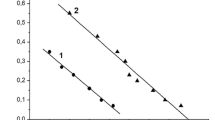Abstract
The mechanism of the histamine-liberating action of the synthetic polypeptide C 44 680-Ba, an alkyl-prolyl derivative of β1–19 corticotrophin, was investigated and compared with those of Compound 48/80, dextran, Melittin and Triton X-100. It was found that the release of histamine from rat peritoneal cells induced by the polypeptide is dependent on temperature, pH, calcium ions and energyproviding processes. In regard to these criteria, the mode of action of this histamine liberator resembles that of Compound 48/80 but is quite distinct from that of the unspecific substance Triton X-100.
Similar content being viewed by others
References
J.H. Baxter,Role of Ca ++ in Mast Cell Activation, Desensitization, and Histamine Release by Dextran. J. Immunol.111, 1470 (1973).
J.H. Baxter, R. Adamiøk, andMd. Bethesda,Temperature Dependence of Histamine Release from Rat Mast Cells by Dextran, Proc. Soc. Exp. Biol. Med.146, 71 (1974).
G.D. Bloom andN. Chakravarty,Time Course of Anaphylactic Histamine Release and Morphological Changes in Rat Peritoneal Mast Cells, Acta physiol. scand.78, 410 (1970).
N. Chakravarty, A. Goth andP. Sen,Potentiation of Dextran-Induced Histamine Release from Rat Mast Cells by Phosphatidylserine, Acta physiol. scand.88, 469 (1973).
W.W. Douglas andY. Ueda,Mast Cell Secretion (Histamine Release) Induced by 48–80: Calcium Dependent Exocytosis Inhibited Strongly by Cytochalasin only when Glycolysis is Rate Limitting, J. Physiol.234, 97 P (1973).
J.C. Foreman,The Mechanism of Spontaneous Histamine Release from Mast Cells, Proc. Physiol. Soc. Lond. 9 P (Nov. 1972).
J.C. Foreman andJ.L. Mongar,Effect of Calcium on Dextran-Induced Histamine Release from Isolated Mast Cells. Brit. J. Pharmacol.46, 767 (1972).
J.C. Foreman andJ.L. Mongar,Activation of Anaphylactic Histamine Release by Calcium and Strontium Ions. Brit. J. Pharmacol.44, 326 P (1972).
B. Fredholm andOe. Haegermark,Histamine Release from Rat Mast Cells Induced by a Mast Cell degranulating Fraction in Bee Venom, Acta physiol. scand.69, 304 (1967).
L.G. Garland andJ.L. Mongar,Inhibition by Chromoglycate of Histamine Release from Rat Peritoneal Mast Cells Induced by Mixtures of Dextran, Phosphatidyl Serine and Calcium Ions, Brit. J. Pharmacol.50, 137 (1974).
R. Gisler andF.M. Dietrich, (unpublished results, 1973).
A. Goth,Effects of Drugs on Mast Cells, Adv. Pharmacol.5, 47 (1967).
A. Goth, H.R. Adams andM. Knoohuizen,Phosphatidylserine: Selective Enhancer of Histamine Release, Science173, 1034 (1971).
N. Grosman andB. Diamant,Studies on the Role of Calcium in the Anaphylactic Histamine Release from Isolated Rat Mast Cells, Acta pharmac. tox.35, 284 (1974).
N. Grosman andB. Diamant,The Influence of Phosphatidylserine on the Release of Histamine from Rat Mast Cells Induced by Different Agents, Agents and Actions5, 296 (1975).
M. Hitchock andM.W. Schneider,Effect of Calcium and Temperature on Histamine Release from Pig Lung by Compound 48/80, Experientia29, 1369 (1973).
B. Högberg andB. Uvnäs,Further Observations on the Disruption of Rat Mesentery Mast Cells Caused by Compound 48/80, Antigen-Antibody Reaction, Lecithinase A and Decylamine, Acta physiol. scand.48, 133 (1960).
R. Jaques andM. Brugger,Synthetic Polypeptides Related to Corticotrophin Acting as Histamine Liberators, Pharmacology2, 361 (1969).
A.R. Johnson andN.C. Moran,Selective Release of Histamine from Rat Mast Cells by Compound 48/80 and Antigen, Am. J. Physiol.216, 453 (1969).
A.R. Johnson andN.C. Moran,Release of Histamine from Rat Mast Cells: a Comparison of the Effect of 48/80 and Two Antigen/Antibody Systems, Fed. Proc.28, 1716 (1969).
A.R. Johnson andN.C. Moran,Inhibition of the Release of Histamine from Rat Mast Cells: the Effect of Cold and Adrenergic Drugs on Release of Histamine by Compound 48/80 and Antigen, J. Pharmac. exp. Ther.175, 632 (1970).
P.G. Krüger,The Histamine Release Process and Concomitant Structural Changes in Rat Peritoneal Mast Cells, Int. Archs. Allergy appl. Immun.51, 608 (1976).
L.M. Lichtenstein, (unpublished results, 1973).
J.L. Mongar andH.O. Schild,Inhibition of the Anaphylactic Reaction, J. Physiol. Lond.135, 301 (1957).
J.L. Mongar andH.O. Schild,The Effect of Calcium and pH on the Anaphylactic Reaction, J. Physiol. Lond.140, 272 (1958).
J.L. Mongar andP. Svec,The Effect of Phospholipid on Anaphylactic Histamine Release, Brit. J. Pharmacol.46, 741 (1972).
J.L. Mongar andP. Svec,Effect of Phospholipid on Histamine Release, Brit. J. Pharmacol.44, 327 P (1972).
N.C. Moran, B. Uvnäs, andB. Westerholm,Release of 5-hydroxytryptamine and Histamine from Rat Mast Cells, Acta physiol. scand.56, 26 (1962).
S. Norn,Antigenic Histamine Release from Fractionated and Unfractionated Peritoneal Cells from Sensitized Rats, Acta pharmac. tox.26, 373 (1968).
S. Norn,Anaphylactic Histamine Release and Influence of Antirheumatics, Acta pharmac. tox.30, suppl. 1 (1971).
A.M. Rothschild,Mechanism of Histamine Release by Compound 48/80, Brit. J. Pharmacol.38, 253 (1970).
M. Rüegg andJ. Szeszak, (unpublished results, 1973).
M. Rüegg andR. Jaques,Tribenoside as an Inhibitor of Chemically Induced Histamine Release, Experientia30, 399 (1974).
M. Rüegg andR. Jaques,Histamine Releasing Effect of a Corticotrophin Derivative. I. Histamine-Releasing Effect of a Nonadecapeptide in Comparison with that of Other Histamine Liberators, Pharmacology15, 134 (1977).
M. Rüegg,Histamine-Releasing Effect of a Corticotrophin Derivative. III. Inhibition of the Histamine-Releasing Activity (in preparation).
P. Sen, A. Goth andN. Chakravarty,Potentiation of Dextran-Induced Histamine Release from Rat Mast Cells by Phosphatidyl Serine, Acta Pharmacol.29, 53 (1971).
I.L. Thon andB. Uvnäs,Degranulation and Histamine Release, Two Consecutive Steps in the Response of Rat Mast Cells to Compound 48/80, Acta physiol. scand.71, 303 (1967).
B. Uvnäs,Release process in Mast Cells and Their Activation by Injury, Ann. N.Y. Acad. Sci.116, 880 (1964).
H. Yamasaki andS. Komoto,Mechanism of Histamine Release by Toluidine blue from Rat Mast Cells, Int. Arch. Allergy41, 854 (1971).
Author information
Authors and Affiliations
Rights and permissions
About this article
Cite this article
Rüegg, M. Histamine-releasing effect of a corticotrophin derivative II. Mechanism of action of histamine release by C 44 680-Ba, compared with that of Cpd. 48/80, dextran and triton. Agents and Actions 9, 148–154 (1979). https://doi.org/10.1007/BF02024726
Received:
Accepted:
Issue Date:
DOI: https://doi.org/10.1007/BF02024726



